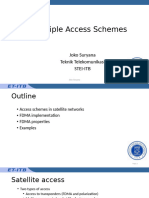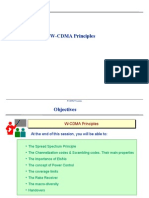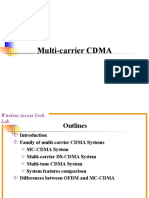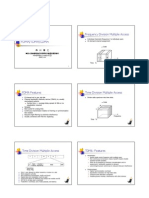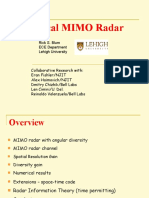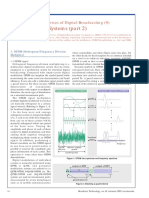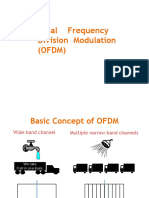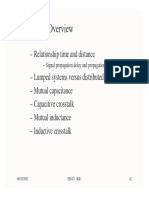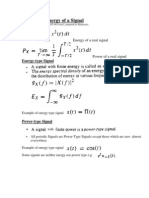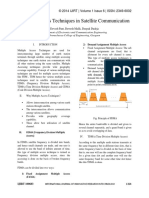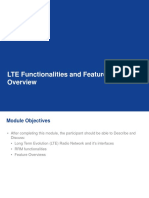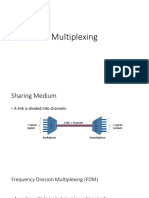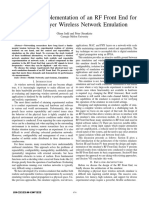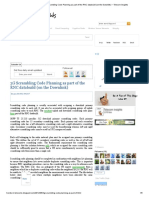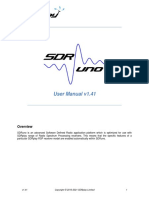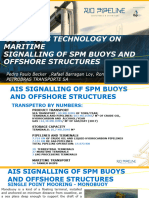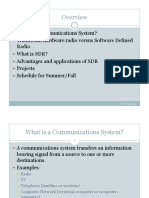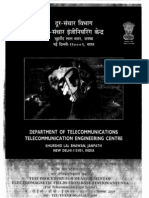Principles of Spread Spectrum and CDMA: DR Bhaskar Ramamurthi
Principles of Spread Spectrum and CDMA: DR Bhaskar Ramamurthi
Uploaded by
hassan abousalehCopyright:
Available Formats
Principles of Spread Spectrum and CDMA: DR Bhaskar Ramamurthi
Principles of Spread Spectrum and CDMA: DR Bhaskar Ramamurthi
Uploaded by
hassan abousalehOriginal Description:
Original Title
Copyright
Available Formats
Share this document
Did you find this document useful?
Is this content inappropriate?
Copyright:
Available Formats
Principles of Spread Spectrum and CDMA: DR Bhaskar Ramamurthi
Principles of Spread Spectrum and CDMA: DR Bhaskar Ramamurthi
Uploaded by
hassan abousalehCopyright:
Available Formats
Principles of Spread Spectrum and CDMA Principles of Spread Spectrum and CDMA
Separation of Overlapping Signals
• Frequency Division Multiplexing
• signals non-overlapping in frequency
freq
Principles of Spread Spectrum • signals overlap in time
f2
and CDMA • separation achieved by filtering f1
- “window” in f-domain time
- convolution with filter impulse response in t-domain
Dr Bhaskar Ramamurthi
Professor • if H 1 ( f ) ↔ h1 ( t ) filters out signal in [f1 , f2]
∞
Department of Electrical Engineering desired_signal = ∫ sum _ signal ( τ )h1 ( t − τ )dτ
−∞
Indian Institute of Technology Madras. ⇒ sliding correlation with h1(-t)
Dr Bhaskar Ramamurthi CDMA_Wireless_Course 1 Dr Bhaskar Ramamurthi CDMA_Wireless_Course 2
Principles of Spread Spectrum and CDMA Principles of Spread Spectrum and CDMA
Separation (contd…) Orthogonality and Separation of Signals
• Time Division Multiplexing • in FDM, signals are orthogonal in frequency
freq
• signals non-overlapping in time ⇒ Signal_1(f) . Signal_2(f) = 0
• signals overlap in frequency • in TDM, signal are orthogonal in time
• separation achieved by windowing ⇒ signal_1(t) . signal_2(t) = 0
t1 t2 tN
− multiplication in t-domain time • signals can be continuous-time or discrete-time
− convolution in f-domain however in TDM, signal is usual a d-t digital signal
or digitally-modulated c-t signal
• if u(t; t1 , t2) is non-zero in [t1 , t2]
desired_signal = sum_signal . u(t; t1 , t2) • Is any other form of orthogonality possible?
Dr Bhaskar Ramamurthi CDMA_Wireless_Course 3 Dr Bhaskar Ramamurthi CDMA_Wireless_Course 4
Principles of Spread Spectrum and CDMA Principles of Spread Spectrum and CDMA
Orthogonality: Any Other Way? Orthogonality (contd..)
• How many orthogonal functions ci(t) can we get?
• Yes, if we consider only discrete-time signals
• Landau-Pollak Theorem: N∼ 2WT where
• Let c1(t) and c2(t) both of duration T be such that
W is the bandwidth available
their cross-correlation = 0 when time-aligned
T ⇒ given symbol duration T,
∫ c ( t )c ( t )dt = 0
1 2
N ∼ W / (1/T)
code
0
• Let signal_1 be x1 and signal_2 be x2 in [0,T]
↑
q
fre
• Consider sum_signal(t)= x1c1(t)+ x2c2(t) bandwidth expansion factor
time
⇒ xi can be extracted by correlating with ci(t) • ci(t) have to be time-aligned, i.e. synchronous
T T • signals overlap in time and frequency
∫ sum _ signal( t ).c ( t )dt =xi [ ∫ c ( t )dt]
i 2
i
0 0
Dr Bhaskar Ramamurthi CDMA_Wireless_Course 5 Dr Bhaskar Ramamurthi CDMA_Wireless_Course 6
Principles of Spread Spectrum and CDMA Principles of Spread Spectrum and CDMA
Orthogonal Direct-Sequence Code Division Multiplexing
Orthogonal CDM (contd…)
• c i(t) are binary-valued sequences such that
T
∫ c ( t )c ( t )dt = 0
i j • Example : Walsh codes
0 L c −1
− i.e., ci(t) = ∑ ( 2 c ki − 1 ) h ( t − T c ) where c k = {0,1},
i
k =0
and Tc is the chip period = T/Lc 0 0 0 0 0 0 H 2n-1 H2n-1
0 1 0 1 0 1 H2n-1 H2n-1
Lc −1 0 0 1 1
• equivalently ∑ cki XOR ckj = Lc H2
0 1 1 0
H2 n
k =0
H2 2
• { c } are called codes, hence the terms CDMA and
i
k
• H2 6 used in IS-95
synchronous CDM
Dr Bhaskar Ramamurthi CDMA_Wireless_Course 7 Dr Bhaskar Ramamurthi CDMA_Wireless_Course 8
Principles of Spread Spectrum and CDMA Principles of Spread Spectrum and CDMA
Asynchronous CDMA Asynchronous CDMA (contd..)
• in orthogonal CDM, codes are synchronised
• even chip alignment will not be there
⇒ difficult to ensure between independent transmitters
at variable distances from receiver (i.e, multiple
access) • if {bk} and {ck} are two truly-random binary sequences
Lc −1
• synchronous orthogonal codes can have large of length Lc, and cross-correlation β = ∑ ( 2bk − 1 )( 2ck − 1 )
k =0
correlation when not synchronised
⇒ not used in CDMA • E[β] = 0 and E[β 2] = Lc
• employ pseudo-random or pseudo-noise (PN) ⇒ interference power from (N-1) signals ∝ (N-1) Lc
sequences x11 x21 • For the signal we desireL to1 extract,
c−
⇒ typically, low but non-zero desired_signal power = [ ∑ ( 2ck − 1 )( 2ck − 1 )] = Lc
2 2
k =0
correlation between any two
sequences x2 2 ⇒ undesired per-user interference suppressed by
x12
factor 1/Lc on the average
⇒ quasi-orthogonal codes
− for large N, variation around average will be less
Dr Bhaskar Ramamurthi CDMA_Wireless_Course 9 Dr Bhaskar Ramamurthi CDMA_Wireless_Course 10
Principles of Spread Spectrum and CDMA Principles of Spread Spectrum and CDMA
Signalling over Fading Channels
• A fading channel has deep nulls in its frequency response Spread Spectrum Signalling and Fading
≡ multiple paths taken by signals from Tx to Rx • c(t) spreads a narrowband signal uniformly
Imp. Freq. over a band T/Tc larger C(f)
Resp Resp
⇒ C(f) must be flat and wide f
τ t 1/2τ f
⇒ Rcc(τ) must be impulse like convolution is uniform
wideband
destructive • multipath signal α1x1 c(t) + α2x1c(t- τ )
Imp. Freq. interference
Resp Resp correlated with c(t)
τ t 1/2τ f ⇒ α1x1 Rcc(0) + α2x1 Rcc(τ) ≈ α1x1Rcc(0) if τ > Tc
• Only a small part of a wideband signal’s spectrum is severely ⇒ delayed signal is suppressed for delay > Tc
distorted by the nulls
• for slow frequency hopping, some bursts of
− in FDM or OFDM, a (narrowband) signal located around symbols falling in spectral nulls are affected
f= 1/2 τ will be lost
⇒ employ coding across bursts to overcome this
• multipath leads to Inter Symbol Interference if τ ~T (symbol
duration)
− in TDM, T is small ⇒ tolerable delay spread is less
Dr Bhaskar Ramamurthi CDMA_Wireless_Course 11 Dr Bhaskar Ramamurthi CDMA_Wireless_Course 12
Principles of Spread Spectrum and CDMA Principles of Spread Spectrum and CDMA
Spread Spectrum Diversity SS Diversity (contd…)
• estimate path delays greater than Tc in a multipath channel • each finger will give α i Rcc(0) x1
• implement one correlator for every significant path :
⇒ combine to get better decision on x1
RAKE receiver
T
∫ • ISI has been resolved and converted to
0
c1(t) diversity gain
T +τ 1
∫ combine
• if path gains [α i ] are also estimated, can weight
τ1
c1(t-τ1)
each finger proportionately
T +τ 2 path gains
∫ ⇒ “maximal ratio” combining
c1(t- τ2) τ2
else “equal gain” combining
RAKE RECEIVER
Dr Bhaskar Ramamurthi CDMA_Wireless_Course 13 Dr Bhaskar Ramamurthi CDMA_Wireless_Course 14
Principles of Spread Spectrum and CDMA Principles of Spread Spectrum and CDMA
Multi-Transceiver (Macro) SS Diversity Macro Diversity (contd…)
• multiple transmissions on same carrier with different
• The fingers of a RAKE receiver need not be fed by same RF
codes can be combined
front-end
⇒ different transceivers at same base station
c(t) (e.g., adjacent sectors)
T
⇒ different base stations!
∫
α1x1 c (t)+ α2x1b(t - τ)
0
b(t)
combiner
T +τ c(t)
∫ T
τ
RF ∫
0
c(t-τ)
combiner
⇒ signals from two base stations can be combined during handoff T +τ
RF ∫
τ
Dr Bhaskar Ramamurthi CDMA_Wireless_Course 15 Dr Bhaskar Ramamurthi CDMA_Wireless_Course 16
Principles of Spread Spectrum and CDMA Principles of Spread Spectrum and CDMA
Multi-Access Interference in CDMA Refinement of MAI Computation
• codes employed have low autocorrelation sidelobes, and • effect of bandpass transmission
typically low cross correlation also - since each interferer will have a random phase
offset (actually, small frequency offset),
• assume all signals arrive with equal power MAI will be less
⇒ perfect power control at Tx to counteract path loss and E[cos2ϕ] = 0.5 for uniformly distributed ϕ
fading
• effect of chip mis-alignment
• desired_signal energy at each RAKE finger ∝ Lc2 − if interference is y1 for left alignment and y1
• sum of undesired-signal (interference) energies at each y2 for right alignment,
RAKE finger ∝ NLc actual interference α y1 + (1- α) y2 where α y2
is uniformly distributed in [0,1]
• if MAI is approximated as Gaussian for large N, E{[α y1 + (1- α)y2]}2 = (1/3) [Ey12 + Ey22] = 2Lc/3
⇒ variance of MAI = NLc • Net effect : CIR increases by a factor of 3
⇒ Carrier-to-Interference Ratio (CIR) = Lc / N • For large cells, thermal noise adds to MAI near
cell boundaries : CINR drops
Dr Bhaskar Ramamurthi CDMA_Wireless_Course 17 Dr Bhaskar Ramamurthi CDMA_Wireless_Course 18
Principles of Spread Spectrum and CDMA Principles of Spread Spectrum and CDMA
Sectoring Reduces MAI Power Control in CDMA
• BS employ sectoral antenna
• if an interferer’s power is higher by, say, 10 times
⇒ downlink adjacent cell interference reduced
⇒ uplink uncontrolled interference from ⇒ equivalent to 10 interferers of equal power
adjacent cells reduced ⇒ CIR drops dramatically
• need to control power of each user to ±0.5dB,
• capacity improvement factor vis-à-vis circular cell
= η × 360o/ sectoral angle (η = 2.8 (4.5) for 3 (6) sectors) - use combination of open-loop and closed-loop
control
• sectoral gain improves link budget in noise-limited situation • path loss due to shadowing similar on up and
⇒ no impact in interference-limited case down links even if frequencies are different
• uncontrolled adjacent sector interference reduces capacity by 0.6 ⇒ open-loop control of Tx power based on local Rx
signal strength
⇒ ~ 0.6 x 60 x η (~35 η) users per cell with variable rate coding
Dr Bhaskar Ramamurthi CDMA_Wireless_Course 19 Dr Bhaskar Ramamurthi CDMA_Wireless_Course 20
Principles of Spread Spectrum and CDMA Principles of Spread Spectrum and CDMA
Power Control in CDMA (contd…) Statistical Multiplexing in CDMA
• individual signal is bursty with activity factor γ
• fading will be different in up and down link (different
frequencies) − bursts occur randomly
⇒ closed-loop control of Tx power based on
feedback from far-end Rx • for large N, total “traffic” at any time t is
- usually a low bitrate binary signal :1/0 → up/down equivalent to γ N non-bursty signals
by 0.5 dB t
• in CDMA, MAI from M bursty signals is not
NPTX/Lc, but γ NPTX/Lc for large N
Open loop Closed loop
• if variable rate voice coder employed
Tx
Tx Tx ⇒ γ ∼ 0.4, N ∼20-30 sufficiently large
feedback
duplexer
control Dplx Dplx • for IP packets, γ ∼ 0.1 or less, but N has to be much
Rx larger due to long-tailed distributions of ON/OFF periods
Rx Rx
Dr Bhaskar Ramamurthi CDMA_Wireless_Course 21 Dr Bhaskar Ramamurthi CDMA_Wireless_Course 22
Principles of Spread Spectrum and CDMA
Pros and Cons of CDMA
• spread spectrum diversity
- multipath, macro
• statistical multiplexing easily exploited
- large number of quasi-orthogonal codes
⇒ large number of bursty users
• easy to support a variety of bit-rates
e.g; if chip rate is 2.048 Mbps service at n kbps, has a
spreading factor of 2048/n
⇒ n can be any power of 2
• strict power control required
- combination of open and closed loop control
• difficult to hand over from one carrier to another
- seamless handoff not possible between carriers, similar to FDM
Dr Bhaskar Ramamurthi CDMA_Wireless_Course 23
You might also like
- Huawei Active Antennas Design Guideline v05 VF-ESDocument35 pagesHuawei Active Antennas Design Guideline v05 VF-ESestebanarca100% (2)
- Lecture 6 Multiple AccessDocument38 pagesLecture 6 Multiple AccessMelda AmaliaNo ratings yet
- Unit+5 +Code+Division+Multiple+AccessDocument35 pagesUnit+5 +Code+Division+Multiple+AccessTariq MatarNo ratings yet
- Data Communications & Computer NetworksDocument31 pagesData Communications & Computer NetworksNeo IctNo ratings yet
- Our presentation FINAL DRAFTDocument19 pagesOur presentation FINAL DRAFTBholu OnlyOneNo ratings yet
- Multiplex AgeDocument102 pagesMultiplex AgeimadNo ratings yet
- An Overview of FMCW Systems in MatlabDocument7 pagesAn Overview of FMCW Systems in MatlabMadhusudhana RaoNo ratings yet
- DCT-OFDM With Index ModulationDocument4 pagesDCT-OFDM With Index ModulationZeyad AlabsyNo ratings yet
- WCDMA PrinciplesDocument41 pagesWCDMA PrinciplesAman DuttaNo ratings yet
- Curs TelemetrieDocument108 pagesCurs TelemetrieIon Daniel-EduardNo ratings yet
- 1 Sistel8Document44 pages1 Sistel8husseinelatarNo ratings yet
- MadXAbhi - Digital Electronics - by MadXAbhi - RobotDocument9 pagesMadXAbhi - Digital Electronics - by MadXAbhi - RobotAkbar SNo ratings yet
- Muli-Carrier CDMADocument36 pagesMuli-Carrier CDMASam SylvesterNo ratings yet
- 8 FM DemodulationDocument8 pages8 FM DemodulationMohamed shabanaNo ratings yet
- Fdma/Tdma/Cdma: Frequency Division Multiple AccessDocument4 pagesFdma/Tdma/Cdma: Frequency Division Multiple AccessKalikwon TomNo ratings yet
- 2GDocument5 pages2GBilal EL MANSSOURINo ratings yet
- Sparsity-Based Time-Frequency Analysis For Automatic Radar Waveform RecognitionDocument6 pagesSparsity-Based Time-Frequency Analysis For Automatic Radar Waveform RecognitionHasan KaradasNo ratings yet
- Lec 11 FM DemodulationDocument8 pagesLec 11 FM DemodulationUmer EhsanNo ratings yet
- ECE 391 Supplemental Notes - #1: Lumped vs. Distributed CircuitsDocument16 pagesECE 391 Supplemental Notes - #1: Lumped vs. Distributed CircuitsAnh Viet NguyenNo ratings yet
- OFDM Technologies and SystemsDocument230 pagesOFDM Technologies and SystemsMANASA P (RA2011004010071)No ratings yet
- EE454 - Modulation FormatsDocument122 pagesEE454 - Modulation FormatsGaurav SharmaNo ratings yet
- EE456 - Digital Communications: Professor Ha NguyenDocument19 pagesEE456 - Digital Communications: Professor Ha NguyenEduardo AvendanoNo ratings yet
- Modulations WDocument34 pagesModulations WJuan PérezNo ratings yet
- Tutorial5 PDFDocument6 pagesTutorial5 PDFIsmail Omary SwaleheNo ratings yet
- Data Communication and MediaDocument17 pagesData Communication and MediactadventuresinghNo ratings yet
- Meher 2019Document4 pagesMeher 2019Madhusudhana RaoNo ratings yet
- Introduction To 4G Communication SystemDocument34 pagesIntroduction To 4G Communication SystemRahul DubeyNo ratings yet
- Statistical MIMO RadarDocument34 pagesStatistical MIMO RadarVanidevi ManiNo ratings yet
- Chapter 6 Multiple AccessDocument49 pagesChapter 6 Multiple AccessYohannes NakachewNo ratings yet
- Evolution of Wireless Communication Systems: Dr. K. Rama NaiduDocument114 pagesEvolution of Wireless Communication Systems: Dr. K. Rama NaidusivakumarNo ratings yet
- Myung2006 PDFDocument5 pagesMyung2006 PDFRoopali AgarwalNo ratings yet
- Peak-To-Average Power Ratio of Single Carrier Fdma Signals With Pulse ShapingDocument5 pagesPeak-To-Average Power Ratio of Single Carrier Fdma Signals With Pulse ShapingMohsin AhmedNo ratings yet
- An 741Document8 pagesAn 741d991622No ratings yet
- Wireless Communication Systems: @cs - NctuDocument54 pagesWireless Communication Systems: @cs - NctugrasspackingNo ratings yet
- EEE 107 Lecture 9 - Analog Pulse ModulationDocument30 pagesEEE 107 Lecture 9 - Analog Pulse Modulation許耕立No ratings yet
- Introduction To OFDM and The IEEE 802.11a StandardDocument34 pagesIntroduction To OFDM and The IEEE 802.11a StandardsegroupNo ratings yet
- MODULATION Systems (Part 2) : Technologies and Services of Digital BroadcastingDocument7 pagesMODULATION Systems (Part 2) : Technologies and Services of Digital BroadcastingDAMIAN AMKELANI LINGANI SIKOSANANo ratings yet
- 1 Diversity Equalisationdiversitycoding-131224031432-Phpapp01Document36 pages1 Diversity Equalisationdiversitycoding-131224031432-Phpapp01husseinelatarNo ratings yet
- COMM1208 Unit6 PCM SamplingDocument13 pagesCOMM1208 Unit6 PCM SamplingidatscribdNo ratings yet
- Wideband Fading ChannelsDocument28 pagesWideband Fading ChannelsHemant GuptaNo ratings yet
- Statistical Channel ModellingDocument18 pagesStatistical Channel ModellingGabriel KiarieNo ratings yet
- Nokia Academy RA4120-60A: Lte Rpess LTE FDD Air InterfaceDocument63 pagesNokia Academy RA4120-60A: Lte Rpess LTE FDD Air Interfacemuhammad fadlun (RAMA)No ratings yet
- Chapter 9Document64 pagesChapter 9Parag Kumbhar07No ratings yet
- Direct-Sequence Spread-Spectrum: Basic PrincipleDocument16 pagesDirect-Sequence Spread-Spectrum: Basic PrincipleSarath ChandraNo ratings yet
- Chapter 2-2024updateDocument63 pagesChapter 2-2024updateGuanyunhNo ratings yet
- ch3 Mitra DSP CDocument67 pagesch3 Mitra DSP CAsad MumtazNo ratings yet
- Module 4Document65 pagesModule 4siddarth.t2021No ratings yet
- WINSEM2023-24 BECE307L TH CH2023240500936 Reference Material I 26-02-2024 Module 4Document62 pagesWINSEM2023-24 BECE307L TH CH2023240500936 Reference Material I 26-02-2024 Module 4Bruce WayneNo ratings yet
- Lec 04 PCSDocument86 pagesLec 04 PCSMuhammad RebalNo ratings yet
- WK 3Document16 pagesWK 3mohammed zubairNo ratings yet
- GPS Signal StructureDocument24 pagesGPS Signal Structurebchaitanya550% (1)
- Multiple XingDocument19 pagesMultiple XingNgurah BimantaraNo ratings yet
- Energy of A Real SignalDocument7 pagesEnergy of A Real SignalmanojniranjNo ratings yet
- Multipal AccessDocument3 pagesMultipal Accessचौकीदार गोपाल भार्गवNo ratings yet
- LTE Functionalities and FeaturesDocument34 pagesLTE Functionalities and FeaturesArun SrivastavaNo ratings yet
- E-Note_28360_Content_Document_20241129112751AMDocument42 pagesE-Note_28360_Content_Document_20241129112751AMsindhu2k03No ratings yet
- Overview of The Third Generation Mobile Communications: Xiaobo ZhouDocument34 pagesOverview of The Third Generation Mobile Communications: Xiaobo ZhoudeerajsoniNo ratings yet
- MultiplexingDocument36 pagesMultiplexingKamya JainNo ratings yet
- UNIT-1: Wireless Propagation Mechanisms, Statistical Multipath Channel Models and Evolution From 1G To 4GDocument83 pagesUNIT-1: Wireless Propagation Mechanisms, Statistical Multipath Channel Models and Evolution From 1G To 4GManas RakshitNo ratings yet
- Microsoft PowerPoint - Spread Spectrum System Part 01Document16 pagesMicrosoft PowerPoint - Spread Spectrum System Part 01hadeer.hNo ratings yet
- Digital Signal Processing Techniques and Applications in Radar Image ProcessingFrom EverandDigital Signal Processing Techniques and Applications in Radar Image ProcessingNo ratings yet
- ZY Smith ChartDocument1 pageZY Smith Charthassan abousaleh100% (1)
- MESFETDocument39 pagesMESFEThassan abousalehNo ratings yet
- Number Systems: ENGR 17 (Ekim) Digital Notes #1Document3 pagesNumber Systems: ENGR 17 (Ekim) Digital Notes #1hassan abousalehNo ratings yet
- Future Mobile HandsetDocument55 pagesFuture Mobile Handsethassan abousalehNo ratings yet
- Cell Search Procedures in LTE SystemsDocument6 pagesCell Search Procedures in LTE Systemshassan abousalehNo ratings yet
- VTC07 GlennDocument6 pagesVTC07 Glennhassan abousalehNo ratings yet
- Tutorial For Automated Design System (ADS) : You Chung Chung Cynthia FurseDocument23 pagesTutorial For Automated Design System (ADS) : You Chung Chung Cynthia Fursehassan abousalehNo ratings yet
- Tower Kill WebDocument23 pagesTower Kill Webhassan abousalehNo ratings yet
- Smartphone Architecture: Evan Mcdonough - Ke Vin We LCHDocument18 pagesSmartphone Architecture: Evan Mcdonough - Ke Vin We LCHhassan abousalehNo ratings yet
- 2012 TWCDocument12 pages2012 TWChassan abousalehNo ratings yet
- Throughput Test Methods For Mimo Radios: 9-Jan-2014 Fanny MlinarskyDocument42 pagesThroughput Test Methods For Mimo Radios: 9-Jan-2014 Fanny Mlinarskyhassan abousalehNo ratings yet
- 3G Scrambling Code Planning As Part of The RNC Databuild (On The Downlink)Document5 pages3G Scrambling Code Planning As Part of The RNC Databuild (On The Downlink)Ahmet ErdilekNo ratings yet
- Telenor Pakistan: HistoryDocument4 pagesTelenor Pakistan: Historysohail naseerNo ratings yet
- Agilia SP MCDocument2 pagesAgilia SP MCTran AnhNo ratings yet
- SDRplay SDRuno User ManualDocument126 pagesSDRplay SDRuno User ManualAhmad Kukuh Al GomezNo ratings yet
- Ultra Small DMR DP-168Document4 pagesUltra Small DMR DP-168Edwin IzaNo ratings yet
- Rio Pipeline 1367 - 19Document19 pagesRio Pipeline 1367 - 19Pedro Becker100% (1)
- Chapter 1 Introduction To Mobile ComputingDocument15 pagesChapter 1 Introduction To Mobile ComputingPalanikumarNo ratings yet
- Pepwave Max Hd2 DatasheetDocument2 pagesPepwave Max Hd2 DatasheetHendra AgustiaNo ratings yet
- Radio Receiver - WikipediaDocument37 pagesRadio Receiver - WikipediaNitish ThakurNo ratings yet
- Performance Analysis of Rayleigh and Rician Fading Channel Models Using Matlab SimulationDocument1 pagePerformance Analysis of Rayleigh and Rician Fading Channel Models Using Matlab SimulationMarlena NeștianNo ratings yet
- CUWSS v1.0 Student Guide - Vol2Document312 pagesCUWSS v1.0 Student Guide - Vol2nawazNo ratings yet
- SM-J400F Common Tshoo 7Document45 pagesSM-J400F Common Tshoo 7Iwan Hadi EfrinCellNo ratings yet
- Microwave Thesis ProjectsDocument6 pagesMicrowave Thesis Projectsdwnt5e3k100% (2)
- 1.1 CDMA OverviewDocument5 pages1.1 CDMA OverviewManjushree PatilNo ratings yet
- Tecnnical InformDocument90 pagesTecnnical InformZafar YabNo ratings yet
- EE162A 2015 Project - PDDocument4 pagesEE162A 2015 Project - PDJose guiteerrzNo ratings yet
- SDR ProjectDocument16 pagesSDR Projectshohobi0% (1)
- Epanl Led: Features & SpecificationsDocument14 pagesEpanl Led: Features & SpecificationsangeloNo ratings yet
- 0.5W CZH-05B PLL 87-108mhz Home FM Transmitter Broadcast Stereo Mic + Short Antenna + Power Supply Cover 300M-1KM - Powered byDocument8 pages0.5W CZH-05B PLL 87-108mhz Home FM Transmitter Broadcast Stereo Mic + Short Antenna + Power Supply Cover 300M-1KM - Powered byShree Vishnu ShastriNo ratings yet
- LTE Link BudgetDocument8 pagesLTE Link BudgetfranciscoNo ratings yet
- Froes2019 ++++ PDFDocument4 pagesFroes2019 ++++ PDFSefa KorogluNo ratings yet
- Scanbridge A2 Skanti: Communication Console For GMDSS Sea Area A2Document48 pagesScanbridge A2 Skanti: Communication Console For GMDSS Sea Area A2Parul MehtaNo ratings yet
- Problems On Principle of CommunicationsDocument2 pagesProblems On Principle of Communicationsnicdocu100% (1)
- Bharat 6G Vision Statement - FullDocument186 pagesBharat 6G Vision Statement - FullNitin JainNo ratings yet
- DSC - Le4000 Lte Wireless Alarm Communicator - Imle - r002 29010077Document27 pagesDSC - Le4000 Lte Wireless Alarm Communicator - Imle - r002 29010077tomredNo ratings yet
- Wireless Product DirectoryDocument36 pagesWireless Product DirectoryFatmir NdrecaNo ratings yet
- User ManualDocument22 pagesUser Manualqwerty123456No ratings yet
- Free Space Optics: The Speed of Fiber The Flexibility of WirelessDocument8 pagesFree Space Optics: The Speed of Fiber The Flexibility of WirelessSaad AhsanNo ratings yet
- TEC-Test Procedure EMF Measurement of Base StationDocument42 pagesTEC-Test Procedure EMF Measurement of Base StationHaresh Jindal100% (1)

